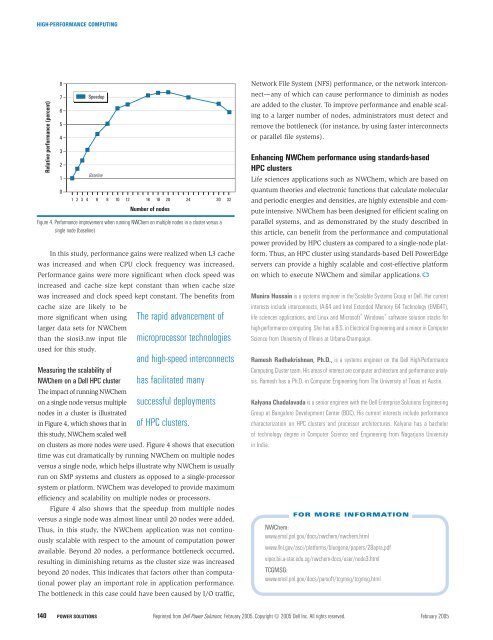Dell Power Solutions
Dell Power Solutions
Dell Power Solutions
- No tags were found...
Create successful ePaper yourself
Turn your PDF publications into a flip-book with our unique Google optimized e-Paper software.
HIGH-PERFORMANCE COMPUTINGRelative performance (percent)87654321In this study, performance gains were realized when L3 cachewas increased and when CPU clock frequency was increased.Performance gains were more significant when clock speed wasincreased and cache size kept constant than when cache sizewas increased and clock speed kept constant. The benefits fromcache size are likely to bemore significant when usinglarger data sets for NWChemthan the siosi3.nw input fileused for this study.SpeedupBaseline01 2 3 4 6 8 10 12 16 18 20 24 30 32Number of nodesFigure 4. Performance improvement when running NWChem on multiple nodes in a cluster versus asingle node (baseline)Measuring the scalability ofNWChem on a <strong>Dell</strong> HPC clusterThe impact of running NWChemon a single node versus multiplenodes in a cluster is illustratedin Figure 4, which shows that inthis study, NWChem scaled wellThe rapid advancement ofmicroprocessor technologiesand high-speed interconnectshas facilitated manysuccessful deploymentsof HPC clusters.on clusters as more nodes were used. Figure 4 shows that executiontime was cut dramatically by running NWChem on multiple nodesversus a single node, which helps illustrate why NWChem is usuallyrun on SMP systems and clusters as opposed to a single-processorsystem or platform. NWChem was developed to provide maximumefficiency and scalability on multiple nodes or processors.Figure 4 also shows that the speedup from multiple nodesversus a single node was almost linear until 20 nodes were added.Thus, in this study, the NWChem application was not continuouslyscalable with respect to the amount of computation poweravailable. Beyond 20 nodes, a performance bottleneck occurred,resulting in diminishing returns as the cluster size was increasedbeyond 20 nodes. This indicates that factors other than computationalpower play an important role in application performance.The bottleneck in this case could have been caused by I/O traffic,Network File System (NFS) performance, or the network interconnect—anyof which can cause performance to diminish as nodesare added to the cluster. To improve performance and enable scalingto a larger number of nodes, administrators must detect andremove the bottleneck (for instance, by using faster interconnectsor parallel file systems).Enhancing NWChem performance using standards-basedHPC clustersLife sciences applications such as NWChem, which are based onquantum theories and electronic functions that calculate molecularand periodic energies and densities, are highly extensible and computeintensive. NWChem has been designed for efficient scaling onparallel systems, and as demonstrated by the study described inthis article, can benefit from the performance and computationalpower provided by HPC clusters as compared to a single-node platform.Thus, an HPC cluster using standards-based <strong>Dell</strong> <strong>Power</strong>Edgeservers can provide a highly scalable and cost-effective platformon which to execute NWChem and similar applications.Munira Hussain is a systems engineer in the Scalable Systems Group at <strong>Dell</strong>. Her currentinterests include interconnects, IA-64 and Intel Extended Memory 64 Technology (EM64T),life sciences applications, and Linux and Microsoft Windows software solution stacks forhigh-performance computing. She has a B.S. in Electrical Engineering and a minor in ComputerScience from University of Illinois at Urbana-Champaign.Ramesh Radhakrishnan, Ph.D., is a systems engineer on the <strong>Dell</strong> High-PerformanceComputing Cluster team. His areas of interest are computer architecture and performance analysis.Ramesh has a Ph.D. in Computer Engineering from The University of Texas at Austin.Kalyana Chadalavada is a senior engineer with the <strong>Dell</strong> Enterprise <strong>Solutions</strong> EngineeringGroup at Bangalore Development Center (BDC). His current interests include performancecharacterization on HPC clusters and processor architectures. Kalyana has a bachelorof technology degree in Computer Science and Engineering from Nagarjuna Universityin India.FOR MORE INFORMATIONNWChem:www.emsl.pnl.gov/docs/nwchem/nwchem.htmlwww.llnl.gov/asci/platforms/bluegene/papers/28apra.pdfviper.bii.a-star.edu.sg/nwchem-docs/user/node3.htmlTCGMSG:www.emsl.pnl.gov/docs/parsoft/tcgmsg/tcgmsg.html140POWER SOLUTIONS Reprinted from <strong>Dell</strong> <strong>Power</strong> <strong>Solutions</strong>, February 2005. Copyright © 2005 <strong>Dell</strong> Inc. All rights reserved. February 2005








